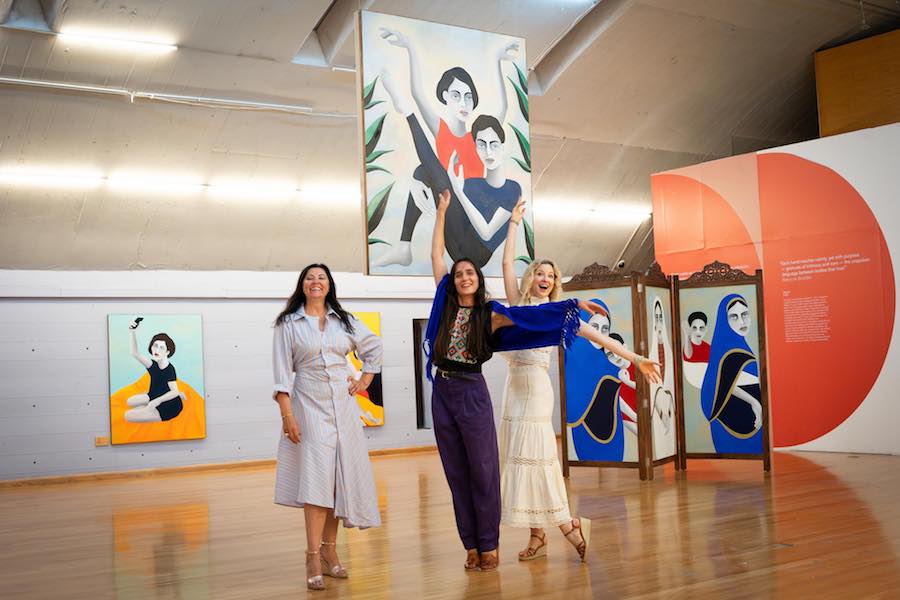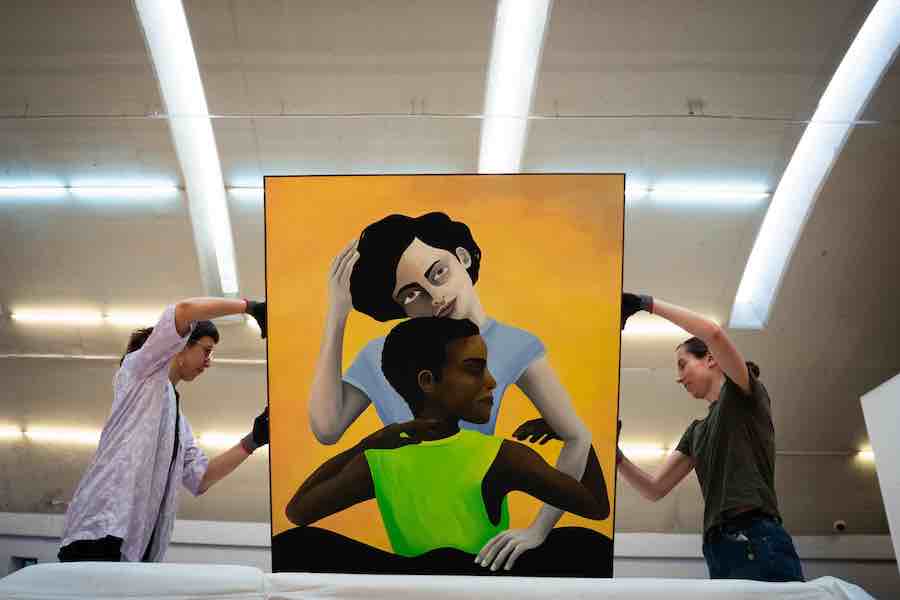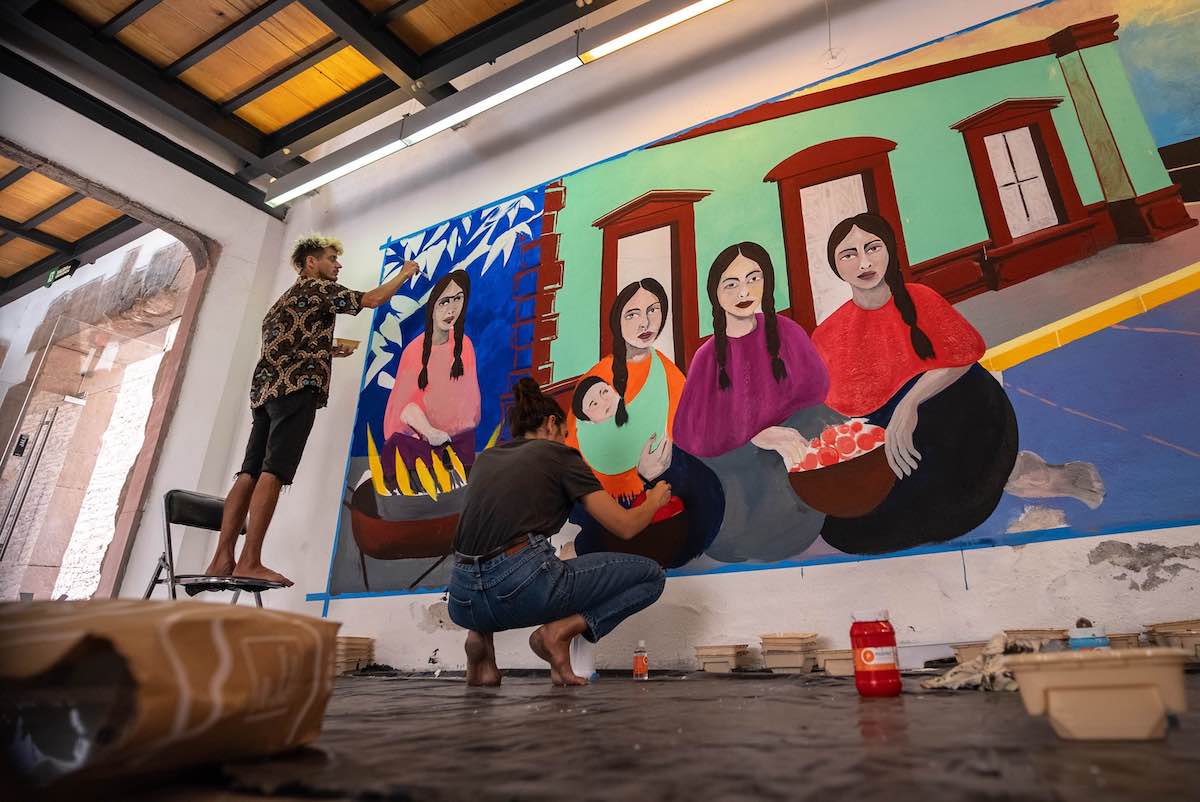The first time I heard someone say San Luis Potosí was on a Zoom call with the AMMA Foundation, based in Mexico City. They had invited me to curate an exhibition with the French/Moroccan artist Rebecca Brodskis, after seeing her solo show at the Kristin Hjellegjerde Gallery in Palm Beach. As Brodskis lived in Marseille, this was a job that required both French and Spanish, a challenge in and of itself – but nothing compared to what the artist would undertake in committing to this show, travelling to Mexico with her young children, and painting a mural while there.
When I looked blankly back at Gerardo Pérez Torres , who was telling me about the cultural arts centre that used to be a former prison (built like a medieval fortress), Luis Alberto Saavedra Nieto kindly pulled up Google Maps and showed me that it was 6 hours north of Mexico City. “How do I get there?” was my first question, to which both chuckled, “It’s super easy, you just jump in an Uber at the airport, then on a bus”. Easy for the native, but not so easy for someone who has never been to Mexico and looks native to Scandinavia. Following this call, I had conversations with my brother and then my husband, who both thought this was a terrible idea. Apparently, Mexico can be somewhat dangerous…
If I were to curate a show on another continent in a venue I did not know, I would need some deep, serious insight into Brodskis’ practice. My work began with a visit to her studio in Marseille; whilst also considered one of the more dangerous cities in Europe, things are changing after a 50 million Euro renovation project for the Olympics, including the dredging and cleaning of the dock (originally built in the 6th century BC by Greek settlers from Phocaea). Upon arrival, one is immediately drawn to the sea. I walked through Le Panier, a pedestrian zone crammed with murals, independent shops, and eateries, and crossed a spectacular bridge (part of the MuCEM complex) to a vantage point on Fort Saint-Jean, overlooking the harbour of Marseille. There, the ocean meets the sky in a giant scoop of such intense blueness that it almost feels like you are flying. I wavered.

That evening, I attended the opening of a group show, “Espaces Hybrides”, which Brodskis had co-curated with Armelle Dakouo and the artists in her studio collective Les Ateliers Lautard (which she established three years ago when relocating from Paris). I met Brodskis at the entrance to Hangar de Mai, leaning effortlessly against the door, a slim leg propped on the frame. Smiling, she spun on her heels and said, “Follow me!” We went in at pace, through the voluminous space brimming with people and art in every conceivable medium (glass, charcoal, oil paint, and screens) – a deep house track tracking us like a film score. Arms reached out as we passed, with Brodskis pausing to greet every smiling face. I was struck by a sense of the familiar; it felt like we were walking through a ‘tableau vivant’ that would later become a painting. I understood then that Brodskis is not just a figurative painter but a builder of worlds full of opportunity for deep social connections.
Born in France and raised between Europe and Morocco, Brodskis’ art emerges from the crossroads of cultures, drawing on her experience of multiple perspectives to reveal a universal language of emotion and gesture that connects us all. Visiting her studio the next day, portraits that had appeared flatter and starker online were pulsing with depth and emotion – as engaging and alive as the characters they portrayed. Idiosyncratic and beguiling, Brodskis’ subjects inhabit the realm of portraiture, but they are not of someone specific. Her compositions are spare and focused, stripping away extraneous detail to foreground the figure, rendered in vivid, layered colours. Bodies seem caught in a moment—like a still from a moving image – by contrast to the busy hum of activity all around her (Brodskis is also a mother of two).

Echoing the stylised portraiture of Modigliani or Dumas, her subjects are distinctive and recognisable; raven-haired, bold featured with strange, lucent eyes that look right through you, with elongated, bare limbs in angular poses. Intensely seductive yet uncanny, she captures the strangeness of social encounters, focusing on mood and psychological presence rather than narrative. “What they feel is what I think we all feel,” she reflects, capturing the spectrum of human emotion—doubt, joy, sorrow, dreams, fear, beauty, and anxiety.”
Meanwhile, Brodskis never stopped painting, moving between canvas and materials like a dancer. I could see how fluid and practised she was, but also how at ease she was now, by contrast with the night before. It was then that I broached the subject of painting a mural whilst in Mexico, not only to leave something in perpetuity there, but also – possibly – to see what experiences she would embody on her journey there and how this would translate into paint. Brodskis seized on the idea with an immediate solution: “I can ask my assistant to join me, so we can finish it on time for the opening.”
Choosing works for the show was remarkably easy, thanks to the generous help of her galleries, Kristin Hjellegjerde and Lara Sedbon. The first painting selected, ‘Dilemma’ (2024), is a large-scale diptych, redolent of Henri Rousseau’s imagined tropical scenes like ‘The Dream’. Somehow it seemed to prefigure Brodskis’ trip to Mexico, lush verdant leaves that might have been drawn from local agave plants, were inspired by the garden outside Brodskis’ studio. An example of the locally observed translating into something universal is that some of the leaves – specifically the lighter, three-toned, heart-shaped variety – had been painted by her assistant, Camille Delcasso. He would be joining Brodskis on this trip to help her complete the central work of the show: a large-scale mural inside the entrance of the Centro de las Artes San Luis Potosí, capturing the most memorable and iconic aspects of Brodskis’ journey through the heart of Mexico.
More a way of life than a methodology, Brodskis’ travels were like mine in my twenties – alive to every opportunity and embodying the experience. Having painted in residencies around the world (Senegal, Mallorca), her work both reflects cultural nuances and engages through the familiarity of gesture: fingers entwined in love, arms extended in isolation or enfolded in trust. She arrived in San Luis Potosí via Oaxaca and Chiapas, the latter inspiring a sketch that would manifest as a mural in this sleepy, yet storied town, two hours north of the tourist hotspot San Miguel De Allende. Crowned the Cultural Capital of the Iberian World 2025, it boasts the sensational pink-walled Leonora Carrington Museum, surreal in both content and scale (I have never seen a gallery this size, with so many bronzes, dedicated to one female artist), linked to a fantabulous sculpture garden in the rainforest of Xilitla, built by the forgotten poet Edward James.
Carrington’s folkish, spectral monumental bronzes looming inside the forecourt of El Centro de las Artes compounded our sense of alienation. Not for the first time that week, I asked myself, What was I doing here? How had I never heard of this place, with its many churches, theatres, and museums, once a silver mining town, now home to multinationals like BMW? Somewhere not yet reconfigured to the needs of tourists, San Luis Potosí is just so very much itself. What would the locals think of an artist from the other side of the world painting a mural that reflected her first impressions of their country? The strange power of portraiture is that it amplifies, but that can be exposing.
Some answers, and my sense of place, would develop in real time as Brodskis painted inside the museum’s busy entrance, offering me the lived experience of art as a tool for meaningful social exchange. Working alongside Delcasso, I watched the artist adapt her process from oil to acrylic and adjust to the tempo of the place, whilst her two children ran around. Throughout this process, the AMMA Foundation team (Gerardo Pérez Torres, Ana Cecilia Acosta Gámez, and Mar Villarroel Maceda were busy receiving the works from overseas, and overseeing the installation of museum graphics, designed by United by (Portugal) https://unitedby.pt. What emerged felt magically real: a vibrant tableau with a nod to Khalo that captured the flavoursome character of daily street life in Mexico, united by the glowing yellow thread of roasting corn. “I’ve always dreamed of coming to Mexico, so naturally I wanted to paint something that reflects this!” Visibly different from the paintings in her accompanying solo exhibition “Un Gesto”, what united them was her ability to capture something universal that transcends cultural specificity.
Her paintings visibly struck a chord on the opening night: children lined up for autographs, visitors asked for photographs next to their favourite works, and the town’s mayor wholeheartedly engaged on our walk through the show (despite my summary in what might be best described as Spanglish). We stopped in front of the work “Echoes of Now” (2024). Two figures, entwined in an embrace, look out at us as if we have interrupted them. Entangled arms reach around and upwards to the edge of the canvas, pale and luminous against the deep blues and greens of the carpet. Like many of her subjects, these figures are androgynous, their relationship ambiguous, and the viewer finds themselves somewhere vaguely familiar but simultaneously strange. Illustrative of how art can empower marginalised voices, surface hidden narratives, and create new opportunities for understanding across cultural and generational divides, for Brodskis, this painting represents something more fundamental. “It is a quiet promise to stand by – no matter what,” she says, and in that moment, we all feel the love.
Rebecca Brodskis, Un Geste / A Gesture / Un Gesto , Centro de las Artes San Luis Potosí, Mexico City, 27 August – 9 November 2025
Visit Here
You can also watch the fabulous documentary made by the wonderful three amigos (Carlos Vargas, Emilio Zizumbo, & Alejandro Neira @rastro___) and a short clip that accompanies a poem for Brodskis.
words and photos: Nico Kos Earle ©Artlyst 2025

